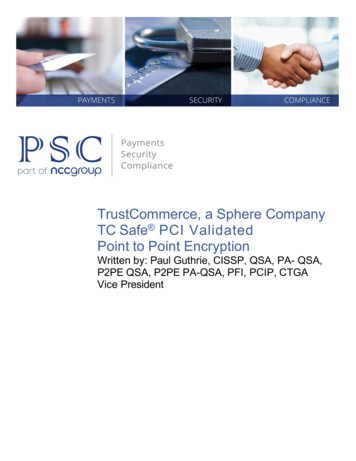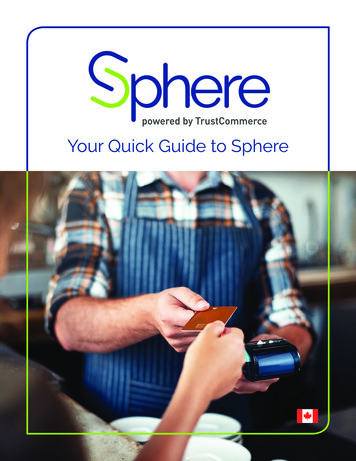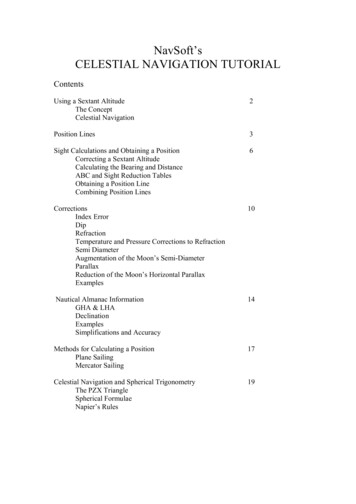
Transcription
TrustCommerce, a Sphere CompanyTC Safe PCI ValidatedPoint to Point EncryptionWritten by: Paul Guthrie, CISSP, QSA, PA- QSA,P2PE QSA, P2PE PA-QSA, PFI, PCIP, CTGAVice President
PSCTC Safe PCI Validated P2PE WhitepaperTable of ContentsTable of Contents1Executive Summary2Overview of P2PE Programs3How P2PE Works3History of P2PE3PCI Validated P2PE4Benefits of Validated P2PE6Risk Reduction6PCI DSS Scope Reduction6Use of Validated P2PE with Tokenization7Use of Validated P2PE with EMV8Validated P2PE Deployment Scenarios9Retail Stores9Kiosks or Unattended Devices9Telephone Order (Call Centers)9E-CommerceTrustCommerce TC Safe PCI Validated P2PE1011Overview of Solution11Devices and Software11Use Case - Healthcare12Challenges12Use of P2PE12Summary14Who is PSC?15Copyright 2018 PSC. All rights reserved.1
PSCTC Safe PCI Validated P2PE WhitepaperExecutive SummaryPoint-to-Point Encryption (P2PE) is a critical technology used to protectcredit card data from being breached. While P2PE has been around formany years, including at TrustCommerce, only PCI Validated P2PEtechnologies such as TrustCommerce’s TC Safe have been tested torigorous standards and should be trusted to reduce risk, and PCI DSS scopeat a merchant.In this whitepaper, we explore PCI Validated P2PE in detail, including howP2PE works within several environments and with other technologies,and how the TC Safe solution may be used to reduce both risk and scopeat retail environments and call centers. We present a challenging usecase (healthcare) and demonstrate how P2PE provides an exceptionalsolution to PCI DSS and credit card security issues within thatenvironment.PSC obtained permission from TrustCommerce to utilize informationgathered during their P2PE Validation process to prepare this whitepaper,including technical support and guidance.Copyright 2018 PSC. All rights reserved.2
PSCTC Safe PCI Validated P2PE WhitepaperOverview of P2PE ProgramsHow P2PE WorksPoint-to-Point Encryption systems protect cardholder data such as theprimary account number (PAN) from the Point-of-Interaction (POI) terminalwithin a merchant’s retail store, to a payment gateway that may decrypt thedata, such as TrustCommerce. A merchant will never have access tounencrypted credit card data, removing entirely this critically sensitive dataelement from their environment, and eliminating the largest source of creditcard data breaches.In a credit card data breach, an attacker gains access to a store orcorporate headquarters and targets any storage or processing of creditcards by using special tools to monitor memory or to scan disks. In a P2PEsystem, there is no unencrypted credit card data, and therefore the onlydata items that might be available to an attacker would be truncated data(e.g. the first six and last four digits of a credit card), encrypted credit carddata, or tokenized credit card data. In each of these cases, there is little thecriminal can do with this data.As such, P2PE is one of the best methods a merchant can use to protecttheir customers, themselves and prevent a credit card breach.History of P2PEP2PE has been around in many forms for over 20 years, with varyingapproaches and degrees of security. There have been many terms or namesapplied, some commercial, and some generic, such as “end-to-endencryption.” There have also been deviations from the principal that datashould be encrypted from the POI device to the payment gateway. Somesolutions only protect data in transit, and other solutions do not encryptwithin the POI device, but rather a connected workstation, leavingcardholder data vulnerable to memory sniffing attacks. Then there aresolutions that decrypt somewhere on the merchant network to re-encrypt thedata before sending on for processing, providing a point of weakness.Some of the less secure solutions have led to significant credit cardCopyright 2018 PSC. All rights reserved.3
PSCTC Safe PCI Validated P2PE Whitepaperbreaches, and in those cases, the merchant mistakenly believed that theywere secure because they were running some form of P2PE; but indeedthey were not. To counter this problem, the Payment Card Industry SecurityStandards Council (PCI SSC) produced a program to provide standards forP2PE solutions, and a high bar that must be met by solution providers to calltheir P2PE products “validated”.PCI Validated P2PEThe PCI SSC is a standards organization created and supported byVisa, MasterCard, American Express, Discover and JCB. Its role for anyof the security standards it supports is to develop and publish the standard,educate and certify third party assessment companies (such as PSC),and in some cases to approve and list solutions based on those standards.In the case of P2PE, the council maintains a list of validated P2PE solutionson their website1 and each of these solutions has been tested and validated tomeet an exceptionally high bar. Some of the required security featuresinclude: Usage of approved hardware devices with approved encryption methods Using or developing secure applications that have had their sourcecode reviewed by a security specialist Creation of a hardened decryption service that uses hardwaresecurity modules to manage keys and decrypt card data.While each of these areas is beyond the scope of this whitepaper, it isimportant to convey that there is a lengthy and challenging audit thatvalidated P2PE solutions have successfully passed. Conversely, solutionsthat are not listed with the council have not had that same level of rigoroustesting applied to them and may not reduce a merchant’s risk in the sameway – in fact they may leave the merchant with a false sense of security.In recognition of the status of using a listed P2PE solution, the PCI SSChas allowed the scope of a PCI Data Security Standard (DSS) assessmentto be greatly reduced, something that is not possible using a non-listedsolution.Copyright 2018 PSC. All rights reserved.4
PSCTC Safe PCI Validated P2PE WhitepaperBenefits of Validated P2PERisk ReductionAs discussed earlier, there is significant risk reduction for a merchant usinga validated P2PE solution. There is no unencrypted cardholder data in amerchant environment, and attackers cannot steal what does not exist.It is critical; however, that a merchant keep their retail environments cleanand do not accept credit card data through non-P2PE interfaces, e.g.maintaining a spreadsheet of their “best customers’” credit cards for easypurchasing. That type of information is best kept using tokens as discussedlater in this paper.The costs of a data breach are extremely significant, and the damage tothe reputation of a merchant severe. In a recent report1, the PonemonInstitute estimated the cost per card of breached credit card data at 141.This includes fines from the card associations through the merchant’sacquiring bank, as well as administrative costs, legal costs and potentiallyfraud costs on the cards.PCI DSS Scope ReductionFor a validated P2PE solution, the scope of the merchant’s PCI DSSassessment is adjusted accordingly2. The rule of thumb is that nothingbetween the encryption environment (i.e. the POI device) and the decryptionenvironment (TrustCommerce) is considered in scope for PCI DSS.Assuming a retail store has no other means of credit card acceptance thatare non P2PE (e.g. a kiosk, linebusters, etc.) then the store network may beconsidered out of sialias?htmlfid faqs FAQ numbers 1158 and 1247Copyright 2018 PSC. All rights reserved.5
PSCTC Safe PCI Validated P2PE WhitepaperMerchant In-ScopeMerchant Out of ScopeService Provider In-ScopeIt is important to note that the store itself is not considered out of scope,because either the merchant or the PCI DSS assessor must consider a setof controls around management of the POI device itself (PCI DSS §9.9) aswell as ensuring the validated P2PE solution is properly implemented withinthe store.This scope reduction is significant as it removes from scope themanagement of both POS workstations and network infrastructure – whichdue to rigorous requirements for hardening, patching, anti-virus and loggingare a challenge to maintain in a large, distributed environment such as achain of retail stores.For merchants working with a PCI QSA (Qualified Security Auditor), theauditor will validate the scope, and provide appropriate scope reductions.Other merchants performing self-assessments may be able to use theminimal SAQ- P2PE, providing they meet all of the eligibility requirements.Use of Validated P2PE with TokenizationValidated P2PE is especially effective when combined with tokenization ofcredit card information. The token replaces the credit card PAN with arandom number, a globally unique identifier (GUID) or some other dataelement that is known only to a payment service provider such asTrustCommerce. Tokens are not considered in-scope for PCI DSS andcannot be stolen by an attacker and reused at another merchant andas such are extremely secure.Copyright 2018 PSC. All rights reserved.6
PSCTC Safe PCI Validated P2PE WhitepaperTokens are useful to merchants in many use cases that require repeated useof a credit card number, where the token may be used as a proxy for thecredit card. Some of these include: Refund back to the original card without the card present Routine (e.g. monthly) or installment charges Correlation with the e-commerce channel to link purchases to thecorrect customerUse of Validated P2PE with EMVEMV is the standard for use of chip cards at the point-of-sale, instead ofswiping the magstripe on the card. EMV can take the form of a “dip” of thecard into the card reader, or a “tap” of the card when using a Near-FieldCommunication (NFC) interface. It is a common misconception that EMVencrypts credit card data and can replace P2PE. It does not. As such, EMVand P2PE technologies complement each other, and in many cases, asmerchants upgrade terminals to allow EMV to work in their stores, they areimplementing P2PE at the same time. Almost all modern POI devicessupport both P2PE and EMV technologies at this time, but not all merchantproviders and/or gateways.Copyright 2018 PSC. All rights reserved.7
PSCTC Safe PCI Validated P2PE WhitepaperP2PE Deployment ScenariosRetail StoresRetail stores are the primary focus of the P2PE standard. By selecting aPOI device supported by the TC Safe P2PE solution and listed withinTrustCommerce’s P2PE Instruction Manual (PIM) , such as the IngenicoGroup iSC250, the merchant may implement the TC Safe solution intheir environment. The PIM provides instructions as to how to receive,set up and manage the POI devices, and other details surroundingthe P2PE solution. It is important that the merchant follow all of theapplicable instructions within the PIM.The scope reduction for the merchant would generally be theentire store network. As all TC Safe supported devices currently onlysupport USB interfaces, it is important to note that the Windowsworkstations that the POI devices are connected to are not considered inscope for PCI DSS, unless they receive cardholder data from a nonP2PE input mechanism such as manual entry on the keyboard.Kiosks or Unattended DevicesKiosks or unattended devices (gas pumps, self-checkout stations, etc.) mayalso utilize validated P2PE solutions as long as they are utilizing a cardswipe, encrypting PIN PAD or other POI technology that is supported bythe TC Safe Validated P2PE solution. TrustCommerce maintains a currentlist of supported devices within their PIM, and the PCI SSC maintains acurrent list on their website, provided earlier.Telephone Order (Call Centers)It is also possible to utilize TC Safe in call center environments, reducingor eliminating from scope the entire network and all call centerworkstations. This requires that all cardholder data entry is performed noton the keyboard of the call center workstation, but instead on anattached POI device such as the ID Tech SREDKey. The customer’sname, order information, address, etc., may be entered on the primarykeyboard, but when the time comes to receive the credit cardinformation including Primary AccountCopyright 2018 PSC. All rights reserved.8
PSCTC Safe PCI Validated P2PE WhitepaperNumber, Expiration Date and CVV2, these must be entered on the POIdevice which will then encrypt the data and fill out the form with encrypteddata. At that point, the TrustCommerce TC Link API as either a component orfull solution may be used to submit the payment to TrustCommerce and(optionally) tokenize the cardholder data for future use.E-CommerceAt this point, there are no validated P2PE technologies in use that supporte-commerce channels. The PCI P2PE standard requires hardwareencryption of cardholder data and the point-of-interaction, and is targetedat card-present transactions, rather than card-not-present such as in ecommerce. There are other security technologies in use to support securityof e-commerce transactions or having the gateway host the payment page,like TrustCommerce’s TC Trustee Premier, to keep the PAN data out of themerchants’ environment, but these are outside of the scope of this document.Copyright 2018 PSC. All rights reserved.9
PSCTC Safe PCI Validated P2PE WhitepaperTrustCommerce TC Safe P2PETrustCommerce has been providing encrypted credit card transactions forover 10 years and has supported encryption of credit card data in transit andstorage since the company’s inception. Validating their solution to the P2PEstandard was the obvious next step in providing assurances to theircustomer base that the security measures already in place met thestringent standards of the payment card industry.Overview of SolutionAny validated P2PE solution is roughly divided into an encryptionenvironment, which exists at a merchant, as well as a decryptionenvironment, which exists at TrustCommerce. The decryption environmentis out of scope for this whitepaper but has been subject to audit through boththe PCI DSS and PCI P2PE standards as is the merchant’s interface to itsacquiring bank’s payment services.The encryption environment includes a POI device supported by TC Safe ,as well as optionally the TC IPA software, which is not considered inscope for PCI DSS when used as part of the TC Safe solution. TheTC IPA software is used to interact with the POI device, and instruct thedevice to take payment, which it returns in encrypted form.The other means of use of TC Safe is via the TC Link API. A merchantthat uses TC Link can integrate a supported POI device and send encrypteddata to the API. Note that the API has always supported transport encryptionusing TLS, but the validated P2PE encryption is required for any scopereduction.Devices and SoftwareThe current list of supported devices can be provided by TrustCommerceas part of their P2PE implementation manual or referenced on the PCISSC website.Copyright 2018 PSC. All rights reserved.10
PSCTC Safe PCI Validated P2PE WhitepaperUse Case - HealthcareChallengesHealthcare organizations have unique challenges when consideringcardholder data security and PCI DSS. Take, for example, a large hospitalcomplex which may be accepting cards at nurses’ stations, patient intake,cafeterias, parking garages, gift shops, opticians, and even third partiessuch as on-site physician practices. All of these acceptance channels likelyshare the same network. As such, without additional segmentation controls,this may bring the entirety of the hospital complex network into PCI DSSscope.PCI DSS requires significant security controls around in-scope networksand systems including hardening, patching, logging, but most importantly,scanning and penetration testing. Running a penetration test, or even ascan on a network segment that can include medical equipment is anextremely dangerous proposition.Up to this time, the primary alternative for a healthcare organization is toidentify all channels of card acceptance and segment all of theworkstations and supporting services to a separate network. This is asignificant undertaking and costly to perform and maintain. It is greatlypreferred that healthcare organizations do not require segmenting of theirnetworks to “payment acceptance” and “nonpayment” – after all, the roleof the organization is to provide health services, not payment services.Use of Validated P2PEP2PE solves this dilemma. Use of a P2PE device connected to aworkstation or network does not bring that workstation or network into scopefor PCI DSS. Additional endpoint controls, mandated by PCI DSS, are notrequired, reducing the amount of overhead that an already burdened ITdepartment may have to support.The P2PE devices may safely share the network segments with medicalhardware or other support devices requiring additional security controls.This brings flexibility and convenience to network design and allows forrapid changes on the network.Copyright 2018 PSC. All rights reserved.11
PSCTC Safe PCI Validated P2PE WhitepaperThe TC Safe solution supports this model and is an ideal solution forthe healthcare market.Copyright 2018 PSC. All rights reserved.12
PSCTC Safe PCI Validated P2PE WhitepaperSummaryValidated P2PE solutions represent the most effective way of protecting cardpresent and agent-entered credit card transactions. By performingencryption in hardware at a POI device and decryption using hardwaredevices at TrustCommerce, card data is protected between these twopoints. This allows a merchant using TC Safe to receive scopereduction from their PCI DSS QSA, or to use the PCI SAQ-P2PE shouldthey be eligible.The TC Safe solution, supporting both a Windows-based paymentsoftware package, TC IPA or an API to the TrustCommerce gateway, TCLink , allows merchants the flexibility of interfaces, as well as anumber of POI devices to choose from.TrustCommerce has raised the bar on their long-standing encryptedpayment service by validating to the PCI P2PE standard and providingtheir customers both the means to reduce their risk as well as their PCIDSS scope.Copyright 2018 PSC. All rights reserved.13
PSCTC Safe PCI Validated P2PE WhitepaperWho is PSC?With offices in the USA, Canada, UK and Australia, PSC is a leadingPCI Assessor and Forensics Investigator Company. We are one of anelite few companies qualified globally to provide expert services andsolutions to organizations that require specialist compliance or consultingsupport in the areas of Payments, Security or Compliance.Our focus is exclusively on clients that accept or process payments ortechnology companies in the payment industry. All staff at PSC haveeither worked within large merchant/retail organizations or servicesproviders. Each partner at PSC has held executive management positionswith responsibilities for payments and security.Our approach includes a high-touch, hands-on methodology, that helpsguide our clients from consideration of strategic alternatives all the waythrough implementation and sustaining activities. The partners at PSC workclosely with Clients to understand their objectives produce pragmatic andactionable plans and aid in execution as required. PSC is certified globally as a Qualified Security Assessor Company(“QSAC”); Payment Applications Qualified Security AssessorCompany (“PA-QSA”) and an Approved Scanning Vendor (“ASV”) for thePCI Security Standards Council.PSC is certified as a Point to Point Encryption Qualified SecurityAssessor Company (“P2PE QSAC”) and Point to Point EncryptionPayment Applications Qualified Security Assessor Company (“P2PEPA-QSA”) for the PCI Security Standards Council.PSC is certified as a PCI Forensics Investigator Company (“PFI”) forthe PCI Security Standards Council.PSC is certified to perform Visa/PCI PIN and TG-3 assessment servicesin accordance with the TG-3 Retail Financial Services ComplianceGuideline (X9 TR-39-2009).PSC is certified as a Verified by Visa (VbV) Assessor Company for Visa Inc.PSC is certified as a Card Production Logical Security, PhysicalSecurity and Over the Air Assessor Company for Visa, Inc.To ensure Independence, PSC does not represent, resell or receivecommissions from any third party hardware, software or solutions vendors.Copyright 2018 PSC. All rights reserved.14
PSCTC Safe PCI Validated P2PE Whitepaperwww.paysw.com 1 (408) 228 0961info@paysw.com591 W. Hamilton Ave, Suite 200, Campbell, CA 95008Copyright 2018 PSC. All rights reserved.15
many years, including at TrustCommerce, only PCI Validated P2PE technologies such as TrustCommerce's TC Safe have been tested to rigorous standards and should be trusted to reduce risk, and PCI DSS scope at a merchant. In this whitepaper, we explore PCI Validated P2PE in detail, including how










